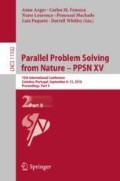Abstract
Extensive efforts so far have been devoted to the design of effective surrogate models aiming at reducing the computational cost for solving expensive black-box continuous optimization problems. There are, however, relatively few investigations on the development of methodologies for combinatorial domains. In this work, we rely on the mathematical foundations of discrete Walsh functions in order to derive a surrogate model for pseudo-boolean optimization functions. Specifically, we model such functions by means of Walsh expansion. By conducting a comprehensive set of experiments on \(nk\)-landscapes, we provide empirical evidence on the accuracy of the proposed model. In particular, we show that a Walsh-based surrogate model can outperform the recently-proposed discrete model based on Kriging.
Access this chapter
Tax calculation will be finalised at checkout
Purchases are for personal use only
Notes
- 1.
Indeed, the matrix \((\varphi _k(x_j))_{jk}\) of dimension \(2^n \times 2^n\) is a Hadamard matrix.
- 2.
Packages CEGO and LARS on CRAN: https://cran.r-project.org.
References
Bartz-Beielstein, T., Zaefferer, M.: Model-based methods for continuous and discrete global optimization. Appl. Soft Comput. 55, 154–167 (2017)
Bethke, A.D.: Genetic algorithms as function optimizers. Ph.D. thesis, University of Michigan (1980)
Chicano, F., Whitley, D., Alba, E.: Exact computation of the expectation surfaces for uniform crossover along with bit-flip mutation. Theor. Comput. Sci. 545, 76–93 (2014)
Chicano, F., Whitley, D., Ochoa, G., Tinós, R.: Optimizing one million variable NK landscapes by hybridizing deterministic recombination and local search. In: GECCO, pp. 753–760 (2017)
Efron, B., Hastie, T., Johnstone, I., Tibshirani, R.: Least angle regression. Ann. Stat. 32(2), 407–499 (2004)
Forrest, S., Mitchell, M.: What makes a problem hard for a genetic algorithm? Some anomalous results and their explanation. Mach. Learn. 13(2–3), 285–319 (1993)
Forrester, A., Keane, A.: Engineering Design via Surrogate Modelling: A Practical Guide. Wiley, Hoboken (2008)
Goldberg, D.E.: Genetic algorithms and walsh functions: Part I, a gentle introduction. Complex Syst. 3(2), 129–152 (1989)
Heckendorn, R.B.: Embedded landscapes. Evol. Comput. 10(4), 345–369 (2002)
Jin, Y.: Surrogate-assisted evolutionary computation: recent advances and future challenges. Swarm Evol. Comput. 1(2), 61–70 (2011)
Jones, D.R., Schonlau, M., Welch, W.J.: Efficient global optimization of expensive black-box functions. J. Glob. Optim. 13(4), 455–492 (1998)
Kauffman, S.A.: The Origins of Order. Oxford University Press, Oxford (1993)
Moraglio, A., Kattan, A.: Geometric generalisation of surrogate model based optimisation to combinatorial spaces. In: Merz, P., Hao, J.-K. (eds.) EvoCOP 2011. LNCS, vol. 6622, pp. 142–154. Springer, Heidelberg (2011). https://doi.org/10.1007/978-3-642-20364-0_13
Shewchuk, J.R., et al.: An introduction to the conjugate gradient method without the agonizing pain (1994)
Tibshirani, R., Wainwright, M., Hastie, T.: Statistical Learning with Sparsity: The Lasso and Generalizations. Chapman and Hall/CRC, Boca Raton (2015)
Walsh, J.L.: A closed set of normal orthogonal functions. Am. J. Math. 45(1), 5–24 (1923)
Zaefferer, M., Bartz-Beielstein, T.: Tabular survey: surrogate models in combinatorial optimization - version 5. Technical report, May 2017
Zaefferer, M., Stork, J., Bartz-Beielstein, T.: Distance measures for permutations in combinatorial efficient global optimization. In: Bartz-Beielstein, T., Branke, J., Filipič, B., Smith, J. (eds.) PPSN 2014. LNCS, vol. 8672, pp. 373–383. Springer, Cham (2014). https://doi.org/10.1007/978-3-319-10762-2_37
Zaefferer, M., Stork, J., Friese, M., Fischbach, A., Naujoks, B., Bartz-Beielstein, T.: Efficient global optimization for combinatorial problems. In: GECCO (2014)
Acknowledgments
This research was partially conducted in the scope of the MOD\(\bar{\text {O}}\) International Associated Laboratory, and was partially supported by the French National Research Agency (BigMO project, ANR-16-CE23-0013-01).
Author information
Authors and Affiliations
Corresponding author
Editor information
Editors and Affiliations
Rights and permissions
Copyright information
© 2018 Springer Nature Switzerland AG
About this paper
Cite this paper
Verel, S., Derbel, B., Liefooghe, A., Aguirre, H., Tanaka, K. (2018). A Surrogate Model Based on Walsh Decomposition for Pseudo-Boolean Functions. In: Auger, A., Fonseca, C., Lourenço, N., Machado, P., Paquete, L., Whitley, D. (eds) Parallel Problem Solving from Nature – PPSN XV. PPSN 2018. Lecture Notes in Computer Science(), vol 11102. Springer, Cham. https://doi.org/10.1007/978-3-319-99259-4_15
Download citation
DOI: https://doi.org/10.1007/978-3-319-99259-4_15
Published:
Publisher Name: Springer, Cham
Print ISBN: 978-3-319-99258-7
Online ISBN: 978-3-319-99259-4
eBook Packages: Computer ScienceComputer Science (R0)

